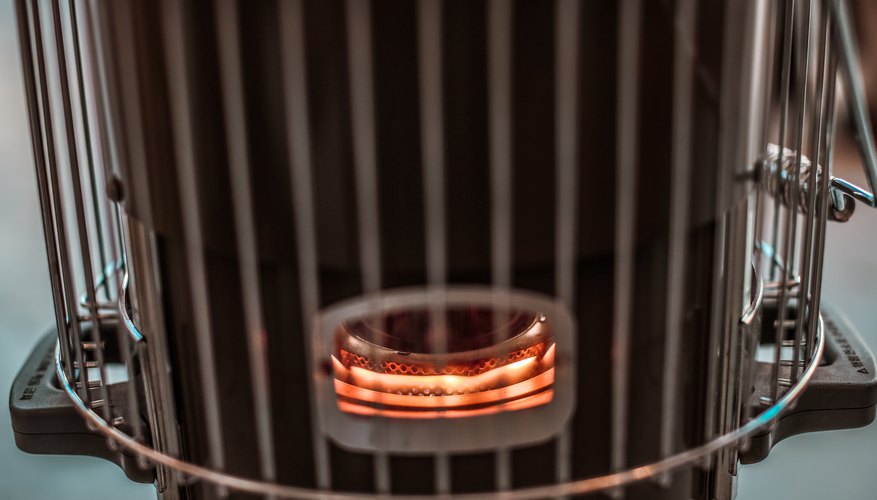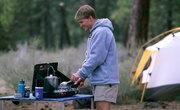
Practicing indoor kerosene heater safety sets the stage for smooth operation with a reduced risk of mishaps. With correct heater placement and plenty of K-1 clear kerosene fuel, you'll be well positioned to add some toasty warmth to your home.
Beware of Kerosene Heater Fumes
Operating a portable kerosene heater indoors is deceptively simple. You plop the unit in a chilly room, fill it completely with kerosene, and turn the knob to the “On” position. Next, the heater's quiet, dependable warmth can often lull you into a false sense of security.
Don't let your guard down, though, as an operational unit regularly emits kerosene heater fumes that can cause some troubling symptoms. In fact, the MedlinePlus notes that kerosene poisoning can affect every system in your body.
First, inhaling the kerosene heater fumes can make it difficult to breathe. Your throat might begin to swell, which may also cause breathing problems. Your blood pressure could also plummet with little warning. You may experience pain in your eyes, ears or nose, and you could even notice a loss of vision.
Your digestive system may also experience negative effects, resulting in stomach pain and possible vomiting episodes. After a bowel movement, you might notice blood in your stools. You can also suffer from skin irritation.
Kerosene fumes can damage your body's nervous system. Besides feeling dizzy and drowsy, you might feel a bit tipsy and stagger around the room. Convulsions and/or seizures may occur, along with episodes of unconsciousness.
Carbon Monoxide Can Be Deadly
If your kerosene heater begins to malfunction and emits harmful fumes, it also releases carbon monoxide gas (or CO) into the surrounding room. Because you can't smell the CO gas, you probably won't notice its presence. However, CO gas is certainly one of the dangers of kerosene heaters indoors.
So, how does the CO gas intrude upon your body? The Children's Hospital of Philadelphia (CHOP) offers an easy-to-follow explanation. When you inhale the CO gas, it reduces the quantity of oxygen that your blood can transport throughout the body.
Your vital organs will also experience decreased oxygen delivery. Because your brain and heart require the most oxygen to operate safely, these major organs can be most severely injured when the supply suddenly slows down.
If you suspect you've been affected by CO gas intrusion, get everyone (including your pets) out of that area quickly. Seek immediate medical care, as you may be suffering serious health effects from the CO exposure. Then, contact your local health authority and/or fuel service provider to alert them of the incident.
CO Poisoning Can Mimic Flu
When the carbon monoxide gas begins to affect your body, you might feel like you're coming down with a nasty case of the flu. However, the CHOP emphasizes that flu symptoms rarely strike every family member at once. In addition, you won't notice any improvement in flu symptoms simply by walking outdoors.
In contrast, CO poisoning affects everyone in the family at the same time. In other words, you'll all feel miserable together. And when you exit the house and begin to breathe uncontaminated air, your symptoms will likely improve.
To decrease the odds that you'll be a CO poisoning victim, place a battery-powered CO alarm in one or more parts of your home. Replace the batteries at least once a year. Finally, providing adequate venting for kerosene (and other fuel-burning) space heaters will help to prevent an unfortunate CO poisoning incident.
Read more: The Use of Accessory Muscles with Breathing
Who Is at Risk?
Not surprisingly, certain groups are especially vulnerable to carbon monoxide exposure. The Mayo Clinic notes that unborn babies' blood cells absorb carbon monoxide more easily than adult blood cells, creating greater potential for damage.
Because young children breathe more frequently than adults, the youngsters are more likely to inhale carbon monoxide. At the other end of the spectrum, older adults are more prone to experiencing brain damage from carbon monoxide poisoning.
People with heart disease and respiratory conditions face an increased risk of illness from a carbon monoxide incident. In addition, anemia patients are more likely to become sick from an incident. Individuals exposed to high levels of carbon monoxide, and who subsequently become unconscious, also merit closer attention.
Because inhalation of combustion fumes can trigger a carbon monoxide incident, you might increase your exposure risk by spending time in an enclosed space where fumes are present. For example, let’s say you’re working on your vehicle’s engine in the garage, and you’ve got the door closed because it’s freezing outside.
To test your adjustments, you crank up the engine, and keep it running for several minutes. If you become distracted, and forget to shut the engine down, you’ll continue to be exposed to the vehicle’s exhaust fumes. Because those fumes contain carbon monoxide, you now face a serious (possibly severe) poisoning risk.
Practice Indoor Kerosene Heater Safety
Promote safe kerosene heater operation by following several ironclad rules for indoor use. Remember that a simple-to-use kerosene heater is still a potential fire hazard, so don't minimize the dangers of kerosene heaters indoors. Take every precaution when you heat your home with this equipment.
The Centers for Disease Control and Prevention recommends that you keep the heater at least three feet away from any flammable object. Examples include furniture, decorative pillows, drapes or bedding. Don't ever place a cover over the kerosene heater.
Don't put the kerosene heater atop a table or other furniture piece. This practice can increase the unit's potential to tip over, and also brings it within close proximity to a flammable object. Keep the device from water as well.
Always ensure that the room is well-ventilated, preferably by opening a nearby window. If that's not possible, open the door to an adjacent room.
Because children are insanely curious, they might be tempted to touch the kerosene heater's surface or fiddle with the controls. To help prevent the chance of serious burns, an adult should closely watch the child at all times.
Unfortunately, accidents can happen even if you practice indoor kerosene heater safety. Be prepared for emergencies by keeping a dry-chemical, multipurpose fire extinguisher in the room in which you'll operate the heater. By planning ahead, you'll decrease the dangers of kerosene heaters indoors.
Can Kerosene Heaters Use Diesel?
The Gloucester City, New Jersey, Fire Department strongly states that you should never use any alternative fuel in a kerosene heater. In fact, the manufacturer's operating manual will likely note that the heater is designed for kerosene fuel.
Don't attempt to fill the kerosene heater with camp stove fuel, surplus gasoline or other flammable liquids. These substances aren't designed for use as a heating fuel, and doing so could invite disaster.
When buying fuel for the fall and winter heating season, ensure that your supplier sells clear Grade K-1 kerosene. Colored kerosene will probably emit smoke, give off a nasty smell, and compromise the wick's function.
In addition, don't attempt to “purify” the kerosene by pouring in additives. These substances can be extremely flammable, and they aren't guaranteed to be effective.
To minimize the chances that you’ll overfill the heater’s fuel reservoir or add more fuel when it isn’t currently needed, ensure that the heater contains an accurate fuel gauge. To help prevent fuel spills, the kerosene heater retailer should furnish you with a siphon pump.
Always Practice Kerosene Heating Safety
Always store the kerosene in a vented metal can with a well-secured lid. Avoid using a red container, and don’t try to repurpose a container that previously contained a flammable liquid.
Mark the container “For Kerosene Use Only” to minimize the chance that someone will fill it with a flammable liquid. Always store the kerosene at a safe distance from any ignition or heat source.
When you’ve finished using the heater, confirm that the flame has gone out before you leave the room. Before going to bed, perform one final check to ensure that the heater has completely shut down. Remember, leaving an unattended heater burning can invite disaster.
Before you refill the kerosene heater, turn it off and wait for it to cool down. Then, take the heater outdoors to fill it. Again, keep the heater away from any ignition source.
To minimize the chances of accidents, keep aerosol sprays, flammable solvents or lacquers in a different room. Don't store gasoline in the house under any circumstances.
References
Writer Bio
Based in North Carolina, Felicia Greene has written professionally since 1986. Greene edited sailing-related newsletters and designed marketing programs for the New Bern, N.C. "Sun Journal" and New Bern Habitat ReStore. She earned a Bachelor of Science in business administration from the University of Baltimore.



